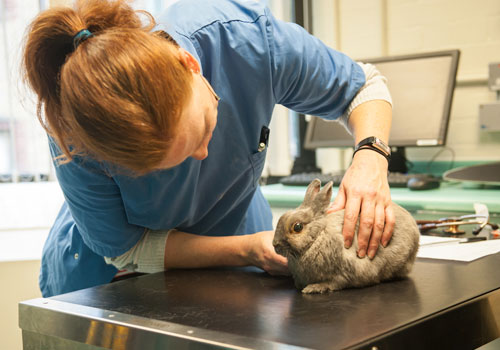Rabbit Health Alert
Sadly we have confirmed the presence of the rabbit haemorrhage disease virus two (RHD2 virus) in London. This is the first time we have diagnosed this fatal disease in this area.
We encourage everyone who has not yet done so to bring their rabbits into the clinic for vaccinations to protect them from this new virus strain.
This means all rabbits indoors and out require vaccinations against both strains each year. The first is for myxomatosis and RHD1 and the second is for RHD2.

Rabbit haemorrhagic disease (also known as viral haemorrhagic disease – VHD) is a calici virus that comes in 2 strains (RHD and RHD2) and affects both wild and domestic species of rabbits.
Transmission
The virus is transmitted through direct contact with an infected rabbit’s oral, nasal, conjunctival secretions and urine and faeces. It can also be transmitted from coming into contact with contaminated objects such as enclosures, contaminated ground, clothes and infected hay/food stuffs. Fleas and mosquitos can also spread the disease and people can unknowingly walk the virus in on shoes if they have been in contact with infected material.
RHD and RHD2
The first strain RHD is very aggressive and rapidly kills between 70 – 100% of rabbits that are infected. This virus strain does not affect baby rabbits under 10 weeks of age. Rabbits get severe inflammation of the blood vessels and die from internal hemorrhages.
The first confirmed case of RHD2 in the UK was in December 2014. Since that time it has spread through areas of the UK and is now in London.
The RHD2 strain is less aggressive, infecting less rabbits in a population and has a lower mortality rate and slower time of onset. Rabbits with RHD2 become ill over several days rather than acute sudden death. The RHD2 strain can affect rabbits under 10 weeks old and can cause illness in hares.
Prevention
There are vaccinations available to protect rabbits from both strains. The standard myxomatosis and VHD vaccine is given from 5 weeks of age and administered once a year. This protects against the original virus strain. A new vaccine against RHD2 has been made available and can be given once or twice yearly depending on the risk to the rabbit. The VHD original vaccine does not provide full protection from both stains so rabbits should be vaccinated against both. High risk rabbits are those living in or travelling to known infected areas, show rabbits, shelter rabbits or those recently adopted, those coming into contact with wild rabbits. Low risk rabbits are indoor rabbits who have no contact with other rabbits wild or domestic.
Our current vaccination recommendations are:
- Low risk rabbits RHD2 A single injection at 10 weeks of age and boosters every year Myxomatosis & RHD1 a single injection from 5 weeks and boosters every year.
- High Risk RHD2 vaccinations can be given earlier than 10 weeks with a subsequent second vaccination at 10 weeks in high risk situations. Booster vaccinations can be given every 6 months in known high risk areas.
Please contact the surgery on 020 7387 8134 to book an appointment.

